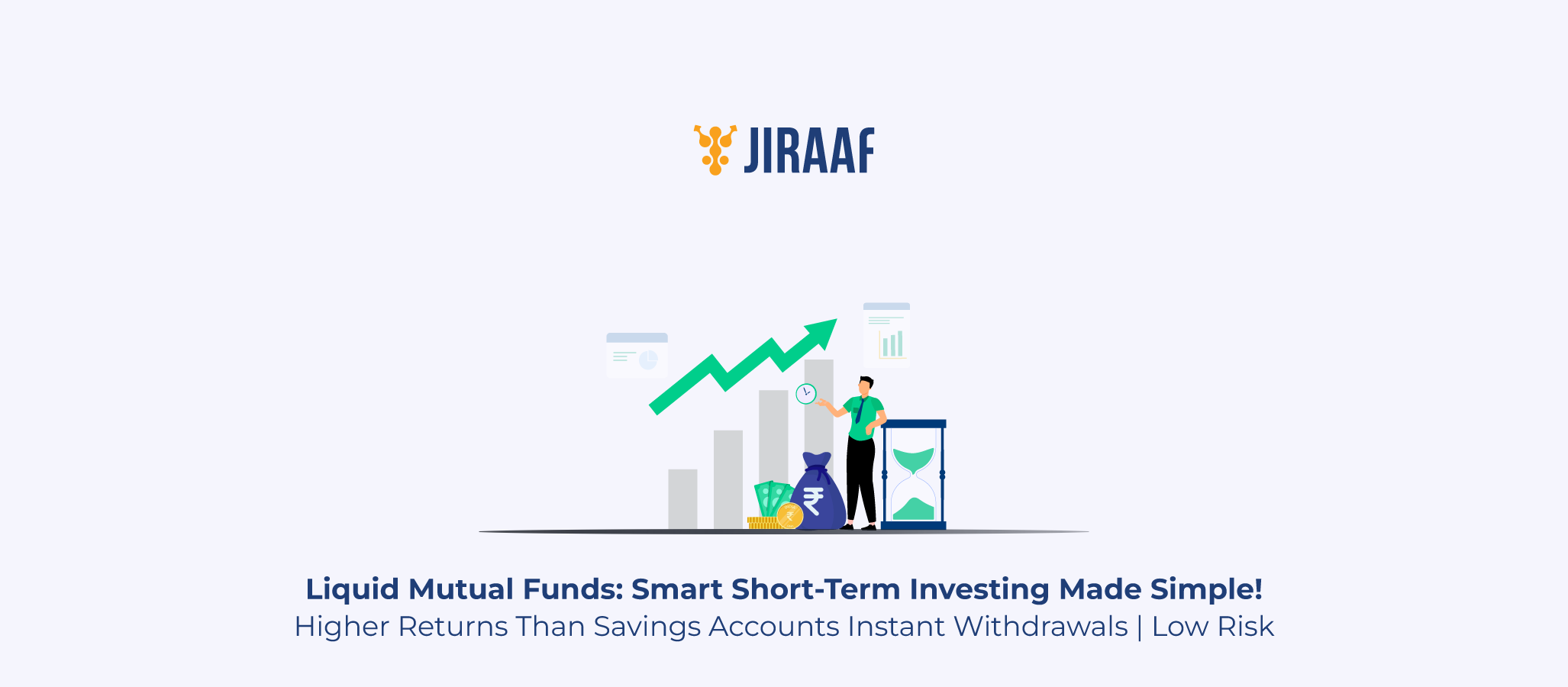What is a Liquid Mutual Fund?
Debt funds that invest primarily in short-term debt securities with maturities as short as ninety-one days are known as liquid mutual funds. Treasury bills, commercial papers, certificates of deposit, and government securities are a few examples of these financial instruments. Since they are grouped according to duration, it requires a firm grasp of your investing horizon. Debt funds have been divided into 16 types, ranging from overnight funds to funds with a seven-year lifespan. SEBI, through this cataloguing, aims to assist investors in selecting the best kind of fund without being overloaded with options.
Benefits of Investing in Liquid Mutual Funds
Liquid mutual funds offer a bunch of benefits as detailed below:
- Lower risk: It is a low-risk debt investment focusing on consistent returns and principal safety. As a result of this, the value is relatively steady across market interest rate cycles. Mutual funds with longer maturity securities, on the other hand, can experience both high capital gains and high losses when interest rates fall.
- Flexibility: If you invest in a liquid mutual fund, you may hold onto your money for as long as you want. Liquid mutual funds feature flexible holding periods, despite a small exit load for redemptions within seven days. For the duration of the investment, this provides safe, market-linked returns while facilitating easy entry and exit.
- Higher potential returns: Liquid mutual funds provide consistent returns during times of inflation, making them a desirable choice with modest but dependable returns.
- Low entry and exit load: Since liquid mutual funds are designed for high liquidity, they typically have low or even zero entry and exit loads, making them an efficient option for short-term parking of funds with minimal transaction costs.
Taxation on Liquid Mutual Funds
Liquid mutual funds offer high liquidity and relatively steady returns, but it’s important for investors to understand the tax implications on gains and income from these funds.
- Capital Gains Tax (Post-April 1, 2023)
Regardless of the holding period, gains from liquid funds are now treated as short-term capital gains and taxed at the investor’s applicable income tax slab rate. This change applies to all debt mutual funds, including liquid funds, market-linked debentures, and unlisted bonds.
- Earlier Tax Treatment (Before April 1, 2023)
- Short-Term Capital Gains (STCG): For investments held less than 24 months, taxed as per the slab rate.
- Long-Term Capital Gains (LTCG): For investments held over 24 months, taxed at 20% with indexation benefit or 10% without indexation.
- Taxation of Dividend
Dividends from liquid funds are also taxed at the individual’s slab rate, and TDS at 10% is applicable if total dividends exceed ₹5,000 in a financial year.
Currently, all the gains from liquid funds, regardless of how long you hold them, are taxed as short-term capital gains at your individual slab rate, making tax planning essential when investing in these instruments.
Risks Involved in Liquid Mutual Funds
Although they are not entirely risk-free, liquid mutual funds are often thought of as low-risk investments. Even though they offer greater liquidity than FDs and better yields than savings accounts, you should be aware of the possible risks before putting your money in one.
- Interest rate risk: Commercial papers and T-bills are examples of short-term debt securities held by liquid mutual funds. Bond prices decline in response to rising interest rates, which temporarily lowers net asset value (NAV). Investors who redeem during rate hikes could suffer slight losses, but the impact is minimal because of the short maturities.
- Credit risk: Certain liquid funds make investments in corporate debt instruments. The fund’s NAV drops if the issuer defaults, as was the case with IL&FS in 2018. To minimize this risk, only invest in funds with at least AAA- rated securities.
- Liquidity risk: Extreme market stress (example COVID-19) may delay redemptions past the customary 24-hour timeframe; however, this is uncommon. Higher redemption pressures are experienced by funds that hold weak securities.
- Reinvestment risk: Over time, declining interest rates reduce returns by forcing funds to reinvest matured securities at lower yields. Investors that retain for long periods of time are impacted.
- Regulatory risk: Tax laws are subject to sudden changes. Most debt funds lost their indexation benefits in Budget 2023; liquid funds were exempted, although returns could be impacted by future changes in policy.
Who Should Invest in Liquid Mutual Funds?
If you are looking to temporarily park excess assets, liquid mutual funds are an ideal option because they offer more liquidity than FDs and better yields than savings accounts.
- Short-term investors: Liquid funds can be attractive if you are looking to make short-term, lower-risk investments. One of the key reasons investors prefer liquid funds is their modest, low-risk returns, typically realized within a short horizon of up to 91 days.
- Emergency fund builders: Liquid funds’ combination of liquidity (T+0/T+1 redemption) and inflation-beating returns is advantageous if you wish to build a 6–12 month safety net. Withdrawals are free, unlike FDs, which makes them perfect for unforeseen costs.
- Corporate treasuries/businesses: In contrast to current accounts, which yield yields of 2-4 percent, businesses with variable cash flows can park extra cash in liquid mutual funds for 1-90 days and earn 5-7% returns. They are ideal for effectively managing working capital without locking money like FDs because of their nearly rapid redemption.
- Senior citizens: If you are a senior citizen seeking regular income, you can combine liquid mutual funds with systematic withdrawal plans (SWPs) to earn monthly payouts.
How to Invest in Liquid Mutual Funds
Compared to savings accounts, liquid mutual funds offer superior returns and are a great way to store short-term excess assets. This is a basic how-to for investing in them:
- Choose the right liquid mutual fund for you according to your assets, capabilities, time-period in mind, and risk tolerance. Check for portfolio quality, AAA-rated mutual funds are better. Compare past returns too.
- Next, select how do you want to invest. Do you prefer a lumpsum investment (ideally ₹5 lakh+), or a systematic investment plan (SIPs) where you regularly deposit some cash.
- Now, you need to open a mutual fund investment account through a mutual fund platform, via a demat account, or directly on the AMC website. Make sure to complete your KYC authorization, if you haven’t done it already.
- Lastly, you can start your investments and keep track of them. Track NAV regularly (though liquid funds have minimal fluctuations) and redeem whenever needed (usually T+0/T+1 settlement).
Conclusion
Liquid mutual funds are an effective short-term investment option, which preserve liquidity and have lower risk than other debt instruments while providing higher returns than savings accounts. These funds offer fast access to cash and tax advantages for holdings longer than three years, making them perfect for emergency funds, corporate treasuries, and investors waiting for market opportunities. They might not be for building long-term wealth, though, as equities funds might produce higher growth. Investors can maximize their growth while reducing risks by selecting top-rated funds with AAA-rated securities and low expense ratios.
Liquid mutual funds are a flexible and low-risk way to achieve short-term financial objectives, whether you’re a business managing cash flow or a citizen creating a financial safety net. Before making an investment, always evaluate your risk tolerance and investment horizon to make sure it fits your financial goals.
FAQs
How is a liquid fund different from a savings account?
Liquid funds maintain liquidity (T+0/T+1 redemption) and provide higher yields (5-7%) than savings account (2-4%). They offer tax benefits for ownership of over three years, although they incur some market risk as compared to savings accounts.
Are liquid mutual funds safe?
Since liquid mutual funds invest in short-duration debt instruments (such as AAA-rated papers and T-bills), they are relatively safe for short-term investments. Unlike FDs, which guarantee capital, they are not risk-free, even though they have minimal credit and interest rate risks. Better returns than savings accounts make it the perfect place to park assets for couple days to a year.
How quickly can I withdraw money from a liquid mutual fund?
Liquid mutual funds allow you to take money out within 24 hours (T+1 settlement), and many of them offer same-day (T+0) redemptions for sums of ₹50,000 or more. For smaller amounts, some platforms even provide instant redemption. They are perfect for short-term cash management or emergency money because they have no lock-in period, unlike FDs.
Who should consider investing in liquid mutual funds?
Liquid mutual funds are ideal for businesses managing short-term cash flow, emergency fund builders requiring quick access to funds, senior citizens wanting steady SWP-based income, and HNIs avoiding TDS on large sums.
What is the meaning of a liquid mutual fund?
A specific kind of debt fund that invests in ultra-short-term securities, such as treasury bills (T-bills), commercial papers, and certificates of deposit with maturities as short as 91 days, is called a liquid mutual fund. It provides better returns than savings accounts, low risk, and high liquidity (withdrawals made immediately or the following day). Perfect for short-term cash parking and generating steady, market-linked returns.
Discover fixed income investments with Jiraaf, a SEBI registered online bonds platform that educates and brings access to a wide array of bonds. Sign up today to explore diversified fixed income investment opportunities to support your goal-based wealth creation journey. Start investing!









